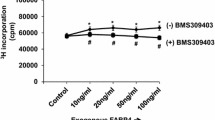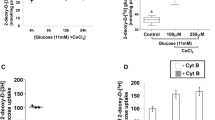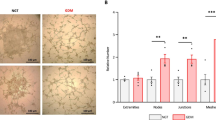Abstract
The study aims to investigate the impacts of hyperglycemia in the presence of fatty acids on early placentation processes that involves tube formation, cellular growth and proliferation, and metabolic activities of the first trimester trophoblast cells. Effects of maternal circulatory glucose levels that mimic physiological (5.5 mM), pre-diabetic (11 mM) and diabetic (≥25 mM) phenotypes on tube formation (as a measure of angiogenesis in vitro), cellular viability and proliferation, fatty acid uptake and expression of genes associated with invasion, angiogenesis and fatty acid metabolism were examined using HTR8/SVneo cells. Glucose (25 mM) induced tube formation, viability, and proliferation of the first trimester trophoblast cells, HTR8/SVneo. Tube formation was, however, disintegrated in the presence of high glucose (40 mM) which was partially protected by eicosapentaenoic acid, 20:5n-3 (EPA) and docosahexaenoic acid, 22:6n-3 in vitro. Glucose (25 mM)-mediated induction in tube formation was favored by increased cellular uptake of [14C]EPA (p < 0.05). Treatment of HTR8/SVneo cells with glucose (25 mM) significantly increased mRNA and protein level of matrix metalloproteinase-9 (MMP9) (p < 0.05). In addition, glucose (25 mM) stimulated the expression of fatty acid binding protein-4, FABP4, and plasma membrane fatty acid binding protein, FABPpm, in these cells (p < 0.05). Glucose-stimulated tube formation in a ‘concentration-dependent’ manner, and this may involve activation of several factors that include MMP9 and fatty acid uptake and metabolism.







Similar content being viewed by others
References
Hill JA (2001) Maternal-embryonic cross-talk. Ann NY Acad Sci 943:17–25
Desoye G, Hauguel-de Mouzon S (2007) The human placenta in gestational diabetes mellitus: the insulin and cytokine network. Diabetes Care 30:S120–S126. doi:10.2337/dc07-s203
Torry DS, Torry RJ (1997) Angiogenesis and the expression of vascular endothelial growth factor in endometrium and placenta. Am J Reprod Immunol 37:21–29
Staun-Ram E, Shalev E (2005) Human trophoblast function during the implantation process. Reprod Biol Endocrinol 3:56. doi:10.1186/1477-7827-3-56
Pinter E, Haigh J, Nagy A, Madri JA (2001) Hyperglycemia-induced vasculopathy in the murine conceptus is mediated via reductions of VEGF-A expression and VEGF receptor activation. Am J Pathol 158:1199–1206. doi:10.1016/S0002-9440(10)64069-2
Yang P, Zhao Z, Reece EA (2008) Blockade of c-Jun N-terminal kinase activation abrogates hyperglycemia-induced yolk sac vasculopathy in vitro. Am J Obstet Gynecol 198:321.e1–321.e7. doi:10.1016/j.ajog.2007.09.010
Belkacemi L, Lash GE, Macdonald-Goodfellow SK, Caldwell JD, Graham CH (2005) Inhibition of human trophoblast invasiveness by high glucose concentrations. J Clin Endocrinol Metab 90:4846–4851. doi:10.1210/jc.2004-2242
Duttaroy AK (2009) Transport of fatty acids across the human placenta: a review. Prog Lipid Res 48:52–61. doi:10.1016/j.plipres.2008.11.001
Johnsen GM, Basak S, Weedon-Fekjaer MS, Staff AC, Duttaroy AK (2011) Docosahexaenoic acid stimulates tube formation in first trimester trophoblast cells, HTR8/SVneo. Placenta 32:626–632. doi:10.1016/j.placenta.2011.06.009
Basak S, Duttaroy AK (2013) Effects of fatty acids on angiogenic activity in the placental extravillious trophoblast cells. Prostaglandins Leukot Essent Fatty Acids 88:155–162. doi:10.1016/j.plefa.2012.10.001
Basak S, Duttaroy AK (2013) cis-9, trans-11 conjugated linoleic acid stimulates expression of angiopoietin like-4 in the placental extravillous trophoblast cells. Biochim Biophys Acta 1831:834–843. doi:10.1016/j.bbalip.2013.01.012
Jauniaux E, Hempstock J, Teng C, Battaglia FC, Burton GJ (2005) Polyol concentrations in the fluid compartments of the human conceptus during the first trimester of pregnancy: maintenance of redox potential in a low oxygen environment. J Clin Endocrinol Metab 90:1171–1175. doi:10.1210/jc.2004-1513
Desoye G, Gauster M, Wadsack C (2011) Placental transport in pregnancy pathologies. Am J Clin Nutr 94:1896S–1902S. doi:10.3945/ajcn.110.000851
Waddell JM, Evans J, Jabbour HN, Denison FC (2011) CTGF expression is up-regulated by PROK1 in early pregnancy and influences HTR-8/Svneo cell adhesion and network formation. Hum Reprod 26:67–75. doi:10.1093/humrep/deq294
Murray MJ, Lessey BA (1999) Embryo implantation and tumor metastasis: common pathways of invasion and angiogenesis. Semin Reprod Endocrinol 17:275–290. doi:10.1055/s-2007-1016235
Jovanović M, Stefanoska I, Radojčić L, Vićovac L (2010) Interleukin-8 (CXCL8) stimulates trophoblast cell migration and invasion by increasing levels of matrix metalloproteinase (MMP)2 and MMP9 and integrins α5 and β1. Reproduction 139:789–798. doi:10.1530/REP-09-0341
Lockwood CJ, Oner C, Uz YH, Kayisli UA, Huang SJ, Buchwalder LF, Murk W, Funai EF, Schatz F (2008) Matrix metalloproteinase 9 (MMP9) expression in preeclamptic decidua and MMP9 induction by tumor necrosis factor alpha and interleukin 1 beta in human first trimester decidual cells. Biol Reprod 78:1064–1072. doi:10.1095/biolreprod.107.063743
Monsonego-Ornan E, Kosonovsky J, Bar A, Roth L, Fraggi-Rankis V, Simsa S, Kohl A, Sela-Donenfeld D (2012) Matrix metalloproteinase 9/gelatinase B is required for neural crest cell migration. Dev Biol 364:162–177. doi:10.1016/j.ydbio.2012.01.028
Luo J, Qiao F, Yin X (2011) Hypoxia induces FGF2 production by vascular endothelial cells and alters MMP9 and TIMP1 expression in extravillous trophoblasts and their invasiveness in a cocultured model. J Reprod Dev 57:84–91
Lappas M (2014) NOD1 expression is increased in the adipose tissue of women with gestational diabetes. J Endocrinol 222:99–112. doi:10.1530/JOE-14-0179
Leach L, Taylor A, Sciota F (2009) Vascular dysfunction in the diabetic placenta: causes and consequences. J Anat 215:69–76. doi:10.1111/j.1469-7580.2009.01098.x
Das MK, Basak S, Ahmed MS, Attramadal H, Duttaroy AK (2014) Connective tissue growth factor induces tube formation and IL-8 production in first trimester human placental trophoblast cells. Eur J Obstet Gynecol Reprod Biol 181C:183–188. doi:10.1016/j.ejogrb.2014.07.045
Basak S, Duttaroy AK (2012) Leptin induces tube formation in first-trimester extravillous trophoblast cells. Eur J Obstet Gynecol Reprod Biol 164:24–29. doi:10.1016/j.ejogrb.2012.05.033
Fragiadaki M, Hill N, Hewitt R, Bou-Gharios G, Cook T, Tam FW, Domin J, Mason RM (2012) Hyperglycemia causes renal cell damage via CCN2-induced activation of the TrkA receptor: implications for diabetic nephropathy. Diabetes 61:2280–2288. doi:10.2337/db11-1138
Han CS, Thung SF, Nickless N, Lockwood CJ, Abrahams VM (2012) Excess glucose levels limit first trimester trophoblast migration and induce an anti-angiogenic profile. In: 32nd Annual meeting of the Society for Maternal-Fetal Medicine the pregnancy meeting 32nd Annual Scientific Meeting 206. 246:doi:10.1016/j.ajog.2011.10.264
Li C, Ren Y, Jia X, Liang P, Lou W, He L, Li M, Sun S, Wang H (2012) Twist overexpression promoted epithelial-to-mesenchymal transition of human peritoneal mesothelial cells under high glucose. Nephrol Dial Transplant 27:4119–4124. doi:10.1093/ndt/gfs049
Li W, Ma Q, Li J, Guo K, Liu H, Han L, Ma G (2011) Hyperglycemia enhances the invasive and migratory activity of pancreatic cancer cells via hydrogen peroxide. Oncol Rep 25:1279–1287. doi:10.3892/or.2011.1150
Figueras M, Olivan M, Busquets S, López-Soriano FJ, Argilés JM (2011) Effects of eicosapentaenoic acid (EPA) treatment on insulin sensitivity in an animal model of diabetes: improvement of the inflammatory status. Obesity (Silver Spring) 19:362–369. doi:10.1038/oby.2010.194
Yokouchi H, Eto K, Nishimura W, Takeda N, Kaburagi Y, Yamamoto S, Yasuda K (2013) Angiopoietin-like protein 4 (ANGPTL4) is induced by high glucose in retinal pigment epithelial cells and exhibits potent angiogenic activity on retinal endothelial cells. Acta Ophthalmol 91:e289–e297. doi:10.1111/aos.12097
Georgiadi A, Lichtenstein L, Degenhardt T, Boekschoten MV, van Bilsen M, Desvergne B, Müller M, Kersten S (2010) Induction of cardiac Angptl4 by dietary fatty acids is mediated by peroxisome proliferator-activated receptor beta/delta and protects against fatty acid-induced oxidative stress. Circ Res 106:1712–1721. doi:10.1161/CIRCRESAHA.110.217380
Basak S, Das MK, Duttaroy AK (2013) Fatty acid-induced angiogenesis in first trimester placental trophoblast cells: possible roles of cellular fatty acid-binding proteins. Life Sci 93:755–762. doi:10.1016/j.lfs.2013.09.024
Elmasri H, Ghelfi E, Yu C-w, Traphagen S, Cernadas M, Cao H, Shi G-P, Plutzky J, Sahin M, Hotamisligil G, Cataltepe S (2012) Endothelial cell-fatty acid binding protein 4 promotes angiogenesis: role of stem cell factor/c-kit pathway. Angiogenesis 15:457–468. doi:10.1007/s10456-012-9274-0
Acknowledgments
We are grateful to Aud Jørgensen for her technical assistance. This study was supported by grant from the Thune Holst Foundation.
Author information
Authors and Affiliations
Corresponding authors
Rights and permissions
About this article
Cite this article
Basak, S., Das, M.K., Srinivas, V. et al. The interplay between glucose and fatty acids on tube formation and fatty acid uptake in the first trimester trophoblast cells, HTR8/SVneo. Mol Cell Biochem 401, 11–19 (2015). https://doi.org/10.1007/s11010-014-2287-9
Received:
Accepted:
Published:
Issue Date:
DOI: https://doi.org/10.1007/s11010-014-2287-9




